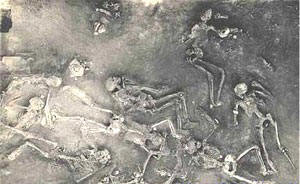In July,16th 1945 the first atomic blast took place in New Mexico. In the early morning darkness the incredible destructive powers of the atom were first unleashed and what had been merely theoretical became reality.
The test was the culmination of three years' planning and development within the super secret Manhattan Project headed by General Leslie R. Groves. Dr. J. Robert Oppenheimer directed the scientific team headquartered at Los Alamos, New Mexico. An isolated corner of the Alamogordo Bombing and Gunnery Range located 230 miles south of Los Alamos was selected for the test that was given the code-name "Trinity."
These were the words that Dr Oppenheimer used to describe the first nuclear blast of modern era.
"We knew the world would not be the same. A few people laughed, a few people cried. Most people were silent. I remembered the line from the Hindu scripture, the Bhagavad Gita; Vishnu is trying to persuade the Prince that he should do his duty and, to impress him, takes on his multi-armed form and says, 'Now I am become Death, the destroyer of worlds.' I suppose we all thought that, one way or another."
But has nuclear explosion taken place before 1945?
Mahabharata which was written 2- 4th BC depicts the war between Pandavas and Kauravas, the battle for Truth.
One of the verse in this text describes a weapon called Bhramastra: "“The explosion was brighter than thousand suns, trees went up in flames and there was this mass destruction. After the blast people who survived started to loss their hair and nails started to fall out”.
Right here is the concise reference to radiation poisoning. Can this weapon be atomic bomb of ancient times?
But is there scientific evidence to prove Nuclear explosion took place before 1945? Archaeological findings suggests so:
In 1992 Indian archeological survey group discovered an ancient city known as “Mohenjo-Daro” literally meaning "mount of the dead" which flourished in 1200 BC.When excavations of Harappa and Mohenjo-Daro reached the street level, they discovered 44 scattered skeletons, as if doom had come so suddenly they could not get to their houses. All the skeletons were flattened to the ground. A father, mother and child were found flattered in the street, face down and still holding hands.
And these skeletons are thousands of years old, even by traditional archaeological standards. What could cause such a thing? Why did the bodies not decay or get eaten by wild animals? Furthermore, there is no apparent cause of a physically violent death. These skeletons are among the most radioactive ever found, on par with those at Hiroshima and Nagasaki.
One it's city, found between the Ganges and the mountains of Rajmahal, seems to have been subjected to intense heat. Huge masses of walls and foundations of the ancient city are fused together, literally vitrified! And since there is no indication of a volcanic eruption at Mohenjo-Daro or at the other cities, the intense heat to melt clay vessels can only be explained by an atomic blast or some other unknown weapon. The cities were wiped out entirely.
While the skeletons have been carbon-dated to 2500 BC, we must keep in mind that carbon-dating involves measuring the amount of radiation left. When atomic explosions are involved, that makes then seem much younger.
Melted Remains
In the forest areas between the Indian mountains of Rajmahal and the Ganges, the explorer De Camp came upon unknown charred ruins. A number of huge masses appeared fused together and hollowed at various points "like lumps of tin struck by a stream of molten steel." The result could not be due to ordinary fire, however violent.
Further south, the British official J. Campbell stumbled upon similar ruins, with a half-vitrified courtyard, produced by an unknown agent.
Similar reports have come from other travelers in the jungle areas, reports of ruined buildings with walls ‘like thick slabs of crystal," likewise holed, split and corroded by some mysterious force.
In his 1979 book “Atomic destruction in 2000 BC” British researcher David Davenport claimed to have found a 50 yard wide epicenter at Mohen-Jo-Daro, where everything appeared to have been fused through transformative process called vitrification.
All this points to the same conclusion: Atomic explosion.
Indian scientists are yet to clarify on this findings, why?!! Is there some conspiracy angle in this, who knows it may well turnout to be a RAW kept secret.
History channel has also made a documentary on this have a look:














